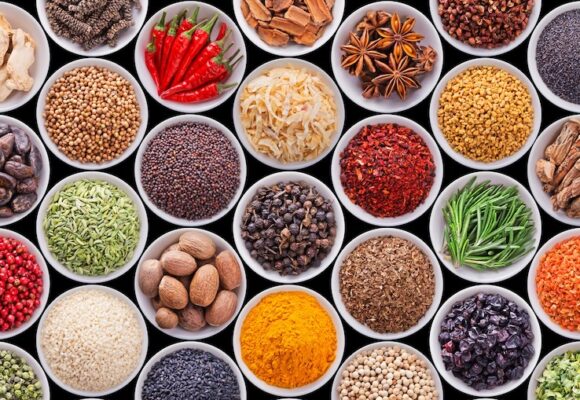
In the food and beverage game, there are few considerations as critical as flavour. While many benefits are powerful enough to convince consumers to try a new product, if it doesn’t taste good, it’s very hard to secure a repeat purchase, let alone brand loyalty.
When Creative Food Innovator and Plant Scientist Dr Hazel MacTavish-West presented on Food Trends and Opportunities for Nuts at this year’s Australian Nut Industry Conference, she touched on a wealth of themes that are currently attracting attention in the food industry. Nestled among the newer trends like plant-based eating, new formats, gut health and fibre, lies the one thing consumers never grow tired of: flavour.
We sat down with Hazel after the conference to continue the conversation and uncover why flavour is so powerful, why umami is the flavour on everyone’s lips, her top picks for new macadamia flavours, the biggest flavour trends on the horizon, and whether there is life after salted caramel.

Flavour: more than just pleasure
It’s easy to think of flavour as something that elicits a ‘yum’ or ‘yuck’ reaction every time you eat or drink. However its influence on human behaviour runs far deeper.
“Initially flavour was about survival,” says Hazel. “The earliest humans used taste as a guide for what was safe to eat. Because of this, flavour and fragrance are deeply embedded in the most primitive part of the brain.”
It’s this relationship that explains why certain flavours evoke feelings of comfort or childhood, for example, and why a flavour or fragrance can so strongly trigger a memory.
From a societal point of view, Hazel sees flavour as playing a vital role in maintaining wellbeing, particularly in older age groups. “How things taste stimulates us wanting to eat more of it, so it’s important that flavour is valued. Our taste buds become less sensitive as we age, so food products need to be designed in such a way that older consumers are tempted to eat well.”
Umami…and more
While sweet, savoury, bitter and sour have headlined the flavour game for years, umami, the lesser-known fifth sibling of the flavour family, seems to be finding its voice.
According to Hazel, the umami renaissance we’re currently seeing is thanks to a growing body of gastronomy research that is decoding umami and discovering how multi-layered this flavour is.
“Umami comes from glutamic acid, which is very closely related to monosodium glutamate (MSG). It explains why MSG became such a popular food additive – it makes everything taste better,” explains Hazel. “But there are lots of foods that naturally contain glutamic acid and therefore have a high component of umami, including tomatoes, seaweed, parmesan cheese and soy sauce. We use these types of foods to lift a dish, for example parmesan cheese on pasta or soy sauce on a Chinese dish. We have all been using them for many years, but until recently we didn’t realise why.”

While our tastebuds love a good hit of umami, there are some combinations that take flavour to another level that Hazel calls ‘umami and more.’
“The best example of umami and more comes from Japan,” she says. “There is a Japanese stock called dashi, commonly used in miso soup, and it contains kombu (dried seaweed), which has the highest umami component of any food. Dashi also contains bonito flakes (dried fish), which gives it ‘more’. The two ingredients combined taste unbelievably good – some say it’s the best tasting thing in the world.”
Other winning ‘umami and more’ combinations include eggs and bacon, cheese and ham, and tomato with beef. The latter explains why sauce is a much-loved burger inclusion. “People think it’s the sugar in the ketchup that makes it good, but it’s actually the tomato and beef combination that makes it so tasty,” says Hazel.
Global flavour fusion
Research commissioned by Australian Macadamias examining global food and beverage trends revealed foods and heritage are merging, catering to our “restless palate syndrome” and products are catering to new flavours and culturally sensitive expressions from other countries.
Hazel echoes this finding and says consumers have become quite specific in their adoption of flavour trends. “Consumers no longer just talk about ‘Asian flavours’, they talk about Thai or Korean flavours, for example. It’s no longer just ‘chilli’, it’s jalapeno or habanero chilli.”
Fusions are increasingly influencing what’s available on the supermarket shelf, with some surprising combinations, such as chilli and fruit, gaining attention. This has occurred largely thanks to an insatiable appetite for adopting flavours from beyond our own shores.
“The UK is looking to American, Mexican and Jamaican flavours, and Australians love looking to Asia for inspiration,” observes Hazel. “Asian consumers are increasingly interested in very spicy flavours as well as western taste trends like salted caramel, and Indian flavours are popular globally at the moment. The rise of turmeric and cinnamon have led to more respect for Indian food and the health benefits it can offer. But once again, consumers aren’t just referencing ‘Indian food’ they’re identifying the food of particular regions, such as North India.”
Hazel has also noted a correlation between the popularity of Indian flavours and the rise of plant-based eating. “Aromatics and spice are done so well in Indian culture, and these flavours work very well in vegetarian cuisine.”
Exploring fertile flavour ground with macadamias
Research and social media insights consistently show that consumers love macadamias in both sweet and savoury products and dishes. They’re enjoyed straight from the shell or simply roasted and salted, and their versatility makes them an ideal carrier for other flavours. Naturally we were eager to know how an expert like Hazel would innovate with macadamias given free reign.
According to Hazel, snacking is the category that demonstrates the most innovative use of flavour globally. However she still sees untapped potential when it comes to how macadamias are used in snack products.
“There are just so many different ways you could go with macadamias,” she says. “Citrus fruits and herbs like rosemary and lavender would be a fabulous counter-point to the buttery base flavour of the macadamia, and those flavours are very on-trend at the moment.”

She also sees the global popularity of Indian flavours as fertile ground for macadamia innovation.
“Indian spices like turmeric, ginger, cinnamon, mustard and chilli would be a flavour powerhouse when combined with macadamias.”
“Multi-layering more traditional but really satisfying smoky, honey and cheesy flavours with macadamias (not all at once) will always deliver a great result,” she says. “And seaweed would be great too. I believe we’re going to see that appearing in all sorts of categories because of its umami flavour and rich mineral content,”
So what would Hazel recommend for product innovators who really want to break new ground?
“I see huge potential off the back of the fermenting trend we have seen. Apple cider vinegar is available in powder form as well as liquid, and I think it could be the next turmeric. A roasted and salted macadamia with a layer of apple cider vinegar powder would taste amazing!”
Where to next?
If there’s one flavour that’s dominated a multitude of product categories and markets in recent times, it has to be salted caramel. But is there something else on the horizon?
“We’re seeing a trend towards floral flavours such as lavender emerging,” says Hazel. “Florals are interesting because they’re a very different, complex flavour. Mustard is set to become a trend – it’s the next wasabi. Mustard has some great health benefits and like chilli, you can add lots for a real hit, or use it more sparingly as an aromatic.”
However the biggest trend Hazel sees coming through is around smoky barbecue and cooked meat notes. In what may initially seem counter-intuitive, this is being driven by the plant-based eating movement.
“Vegans and vegetarians, while increasing in number, are still a small part of the market,” explains Hazel. “It’s the larger number of people who have reduced, but not eliminated their meat intake, who are having greater impact. That’s why we’re increasingly seeing ‘fake meat’ products, because it’s an easier switch for everyday consumers.”

As she noted in her 2018 Churchill Fellowship report, Hazel says “Some people who choose not to eat meat actually like the taste, texture and satisfaction of eating meat. Thus, creating products that “eat like meat” is an important focus for developers, to meet the needs of all flexitarians. Flavours (are) particularly key for achieving this: smoky, peppery, barbecue and umami notes (are) frequently used, to help them ‘taste more like meat’.”
Hazel sees this as a huge opportunity for nut producers. “I would really like to see nuts being used beyond snacking a lot more. Replacing meat shouldn’t just be about legumes and soy. We need to look at nuts as the centre of the meal, and get more innovative with products like nut burgers and even nut roasts, initially rolled out in the 1970’s. It’s a challenge I’d like to see more product developers tackling.”
Wherever the flavour game goes next, it’s sure to be a fascinating ride for developers and consumers alike. If you’re developing a new product combining macadamias and innovative flavours, be sure to let us know. To see some of the unique flavour combinations in product concepts from the Macadamia Innovation Challenge, contact your Australian macadamia supplier or email Lynne Ziehlke.
To speak to Hazel about a specific food innovation challenge, or to take part in a regional or nut-focused workshop, visit her website: www.mactavishwest.com.au


